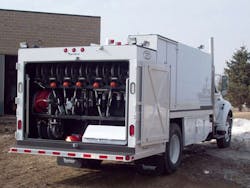How a Fleet Masters Winner Does Oil Analysis
“Anybody who doesn’t [use oil analysis] better start.”
That’s the plainspoken advice of three-time Construction Equipment/AEMP Fleet Masters winner Mike Brennan, CEM, fleet manager for Manatee County, Fla.
“No. 1, any machine that you buy, if you’re not doing oil analysis on all the compartments, you’re not covered under warranty,” Brennan says. “If you read that agreement, it will tell you in there you need to do that.”
It’s a warranty condition in both basic and extended warranties, Brennan says.
“The other issue is zeroing in on PM and your PM cycle. Depending on your operations and climate conditions, things are different,” he continues. “My machines are different than somebody else’s on the other side of the country. So what we have to do is monitor those compartments to see what the condition of the machine is and then adjust our PM schedules based on compliance with the oil analysis we get back.”
There may be instances when the oil drain intervals can be extended to keep a machine in the field a little longer for additional productivity.
“Let’s say on engines, you need to do that oil analysis on the OEM-recommended interval and establish a baseline,” Brennan says. “Then you may run it out another 100 or 200 hours, or 3,000 miles, do another oil analysis there, then change the oil, because you don’t know.
“When you get that result back, you’ll say okay, the oil was good this far out. So we do that in another machine and we get several hits that look like the oil is still in good shape—then maybe we can think about extending [the interval] a bit,” Brennan says.
“In the oil analysis, we look at the TBNs, we look for silicate, and any water,” Brennan explains. “The silicate and the water will tear down your bearings, bushings, and controls, so when you start seeing that, you’ve got a source of entry. And that triggers a larger maintenance inspection.
“We do it pretty religiously when we’re thinking about compartment service. Say I’ve got a 1,000-hour PM coming up on a D8,” Brennan says. “Generally what we’ll do is somewhere right before that service is due, we’ll pull those oil analyses and send them off, so before that machine comes in, we’ve got an idea of what we’re getting into when it comes in, and we can better schedule that work.”
Manatee County’s oil analysis program looks at its on-road trucks, off-road equipment, and even light trucks. “We go down into our light trucks just to validate our PM interval, and we do that from time to time,” Brennan says. “One thing a lot of people miss is that you have to do an analysis on your virgin oil, too, so you can have a baseline of what that oil really is.”
Brennan says managers should test virgin oil right out of the tank or container. Sending it in for analysis, unused, is the only way to truly know what you’re working with.
“Other than that, you don’t have a comparison,” he says. “How do you know if '7.5' is good or bad if you don’t know what the oil had to start with? We pull it right out of our bulk tanks. And what if the guy puts the wrong oil in there?”
Manatee County runs most of its oil samples through its local Cat dealer, which has a regional lab nearby. In most cases it has a 24-hour turnaround. If there’s a major problem, there is immediate contact.
“If they have a finding that’s a red flag, my supervisors and operational chiefs will get an instant email to shut the machine down,” Brennan says. “Water in the oil, or anything like that, is a shut-the-machine-down situation. Or, it could be a final drive where we’ve got heavy silicate, and then you’re seeing brass or lead and you know you’ve got a bearing going or something like that.”
The county typically buys oil sample kits in boxes of 10, with pre-paid address stickers for shipping. “We bill them out as an individual part and capture all those costs against the machine,” Brennan says.
